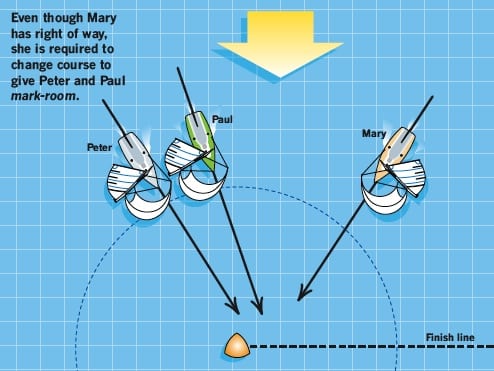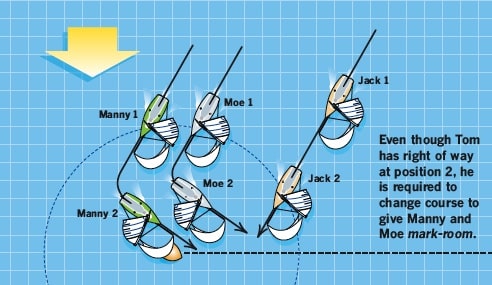Within a single week readers sent me two questions on the same topic: How do the rules work between boats on opposite tacks coming into a leeward mark to be passed or rounded to starboard?
One reader was looking for “the rule dealing with downwind finishes,” but of course they couldn’t find it because there is no single rule that covers only those situations. Both readers commented that under the 2008 rules there was a sentence in the preamble to Part 2’s Section C stating that when the mark-rounding rule, Rule 18, applied, it took “precedence” over the port-starboard rule, Rule 10, but they couldn’t find that either. That sentence is no longer in the rulebook. There are several ways in which the current rules differ from the 2008 rules, but the “game” at leeward marks left to starboard has not changed. Here’s how the current rules apply to Peter, Paul, and Mary’s predicament shown in the first diagram.

Peter, Paul, and Mary had been on the courses shown for several lengths. Peter and Paul were overlapped on port tack as they entered the zone at the pin end of the finishing line. Mary was on starboard tack on a collision course with Paul. Mary hailed “Starboard,” and Peter hailed “Room.”
Clearly, Peter had an inside overlap on Paul. All three boats had been sailing more than 90 degrees off the wind for some time. Not so obvious is that both Peter and Paul had inside overlaps on Mary and they had those overlaps even before they reached the zone. This is implied by a new-in-2009 sentence in the definition Clear Astern and Clear Ahead; Overlap that tells you that the term overlap applies to boats on opposite tacks when “Rule 18 applies” or “both boats are sailing more than ninety degrees from the true wind.”
Rule 18 began to apply between Peter and Paul, Peter and Mary, and Paul and Mary when the first of each pair reached the zone. Under Rule 18.2(b), the outside boat of each pair was required to give the inside boat mark-room. However, at that same time, Rule 10 gave Mary right of way over Peter and Paul. Here is the crux of the problem that the questioners had in applying the rules. They were unsure how to handle the fact that Mary was required by Rule 18.2(b) to give Peter and Paul mark-room while at the same time Peter and Paul were required by Rule 10 to keep clear of Mary.
If a boat has right of way, which she can have under Rule 10, 11, 12, 13, or 21, she has the right to sail her course with no need to avoid the boat required to keep clear of her. Readers of the rulebook tend to focus on particular rules and not to read the preambles to the various sections of the rulebook. But, sometimes those preambles are important. The preamble to the right-of-way rules in Section A states, “A boat has right of way when another boat is required to keep clear of her. However, some rules in Sections B, C, and D limit the actions of a right-of-way boat.” Mary has right of way under Rule 10, but Rule 18, a rule of Section B, limits her actions by requiring her to give Peter and Paul mark-room.
This discussion implies that even though Mary has right of way, she is required by Rule 18.2(b) to bear off and, if necessary, jibe in order to give both Peter and Paul mark-room. Mark-room is room for Peter and Paul to sail to a position close alongside the mark and then room for each to sail his proper course, which is the course he would sail to finish as quickly as possible if Mary were not present. If Mary gives them that room, then they must keep clear of her. If she does not give enough room and if, as a result, Paul breaks Rule 10 with respect to Mary or Rule 11 with respect to Peter, Paul will be exonerated under Rule 18.5. Similarly, if Mary’s failure to give enough room compels Peter to hit the mark, he will be exonerated under Rule 64.1(c).

Now let’s turn to a related situation shown in the second diagram. Here Manny and Moe, sailing sportboats with spinnakers set on sprits, were overlapped on starboard tack when they reached the zone at the finish line pin, and Jack was clear astern on starboard tack and on a track a couple of lengths to leeward of the other two. After entering the zone, Manny and Moe jibed to port tack, putting Moe on a collision course with Jack.
There are just slight differences in how the rules apply here as compared to the previous situation shown. Manny and Moe were both clear ahead of Jack when
they reached the zone. Therefore, Rule 18.2(b)’s second sentence applied. It put the same obligation on Jack that the rule’s first sentence put on Mary in the situation described earlier. It required Jack to give both Manny and Moe markroom. When Manny reached the zone he was overlapped inside Moe, so Moe was
required by Rule 18.2(b)’s first sentence to give Manny mark-room. Manny chose to sail to the mark on the track shown between positions 1 and 2, which included a jibe, and Moe gave him room to do so. After Manny and Moe had sailed to a position close alongside the mark, each was entitled to room to sail his proper course. After position 2, the rules apply to Manny, Moe, and Jack just as they did to Peter, Paul, and Mary.









